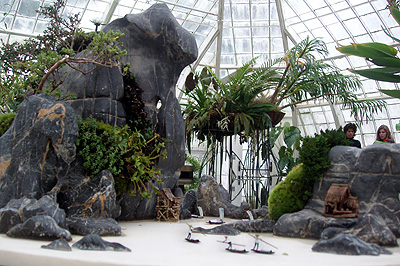
Penjing are small dioramas that depict idyllic scenes in a tray using stones and living plants, carefully selected and arranged for the desired effect. The art form dates back at least 1300 years in China. Tree penjing was a style that showcased miniature trees, an art form familiar today as bonsai. Landscape penjing is another variety that creates three-dimensional versions of the idealized landscapes depicted in traditional Chinese painting. The stones used are selected for texture and form that represent in miniature a fantastic geology of caverns and dizzying vertical drops. Plants are added to make the arrangement come alive. The scenes are populated only by the occasional hut and the little boats that wend their way through the landscape.
An exhibit of ten landscape penjing is currently on view in the aquatic plant room of the Conservatory of Flowers, the big Victorian greenhouse in San Francisco's Golden Gate Park. They will be there until April 27, 2008. The photograph above is closeup of one of them and others can be seen at Flickr.
Tray landscapes were popular during the Zymoglyphic Era of Oriental Influence. The only one currently in the museum's collection shows more of an emphasis on whimsical, rather than idyllic, theme and the use of strange dried stuff in place of stones and living plants.
An excellent book on penjing is
Penjing: Worlds of Wonderment: A Journey Exploring an Ancient Chinese Art and Its History, Cultural Background, and Aesthetics
The Conservatory show was reviewed in the San Francisco Chronicle
Previous Web log entries on oriental nature-based arts:
Chinese root carving
Ikebana - Japanese Flower Arranging
No comments:
Post a Comment